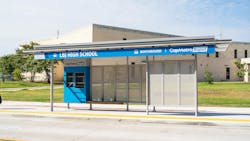Best Practices: CapMetro takes an equitable approach to distributing bus stop amenities
In the summer of 2022, Capital Metropolitan Transportation Authority (CapMetro), the transit authority for Austin and the Central Texas area, began the typical process of updating its service standards and guidelines. As part of the update, the agency also determined how to go beyond the federal requirement of Title VI with an amenities enhancement process that aimed to not only equally, but equitably distribute amenities.
Central to CapMetro’s process was community feedback. The agency asked transit riders and the surrounding communities what works best for them and how the placement of amenities should be prioritized. In the fall of 2022, the agency reviewed the responses, which indicated that all bus stops should have seats and shelters, and that stops with more ridership should have extra amenities. They also said CapMetro should prioritize improving bus stops that are used by people who need them most, like bus stops near services for people with disabilities or seniors.
In 2023, as Austin experienced its hottest summer, more inquiries and requests came in calling for increased shade and other amenities to protect riders from the sun. The requests for sun protection came from every direction, including community members using CapMetro services, non-profits, city departments, university students and more. CapMetro accelerated the implementation of the amenity enhancement process, approved and championed by its board in June 2023.
Amenity enhancement process
CapMetro used the newly approved guidelines, which provided standards for where stops are placed to support safety, speed and access and identified the types of amenities needed for various types of stops. Stops were classified using several variables, including ridership, service type and customer wait time (i.e., how often the bus arrives at a stop).
Thanks to community feedback, CapMetro retained the threshold that stops with an average daily boarding of 50 riders require a shelter and added language that a shelter, while not required, is vital for stops with an average daily boarding of 15 riders and/or stops with longer wait times. This change in terminology flagged many more stops as potentially needing amenities, particularly those in areas with historic disinvestment. CapMetro worked quickly to implement new amenities using stop classifications, along with an amenities enhancement process that prioritizes equitable placement of amenities using the following criteria:
- Proximity to those more likely to use transit (Data: Black, Indigenous, People of Color, low income, car-free households, people with limited English, older adults, young people, people with disabilities and Justice 40 populations).
- How long customers wait for the bus (Data: Route frequency by stop).
- The number of key destinations near a stop and reliability of pedestrian connectivity to stops (Data: Key destinations and sidewalk infrastructure).
- Customer requests (Data: Customer calls and messages with specific stop amenity requests).
What has implementation looked like?
CapMetro's prioritization process effectively guided agency staff in the initial review of stop needs. However, the process found that stops located in areas that have historically experienced disinvestment often required additional infrastructure improvements before amenities could be installed. As a result, the adding amenities became more time-consuming and costly for the areas that needed support the most.
CapMetro had limited funding for additional infrastructure improvements needed before installing amenities. The agency expanded its database, built an Airtable to track all the happenings at every stop to help identify opportunities to leverage funding from adjacent infrastructure projects, new developments or new transit services near a bus stop in need of a shelter. This strategic maneuver brought down the upfront project costs and effectively used resources so that more shelters could be installed.
As the adage goes, right place, right time. The agency’s look to enhance programming around bus stops took place at just the right time, as 2024 was one of Austin’s hottest summers on record. CapMetro’s community-guided policy on an equitable distribution of amenities, paired with a database that leverages available resources, supported CapMetro’s implementation of more amenities and shelters across the city.
CapMetro continues to implement its process of installing amenities across the transit system to provide a sense of dignity to customers and much-improved riding experiences. Afterall, all trips on public transit start and end at a bus stop.
About the Author
Emma Martinez
Senior Planner
Emma Martinez is a senior planner at the Capital Metropolitan Transportation Authority (CapMetro).
Rose Lisska
Principal Planner
Rose Lisska is a principal planner at the Capital Metropolitan Transportation Authority (CapMetro).
